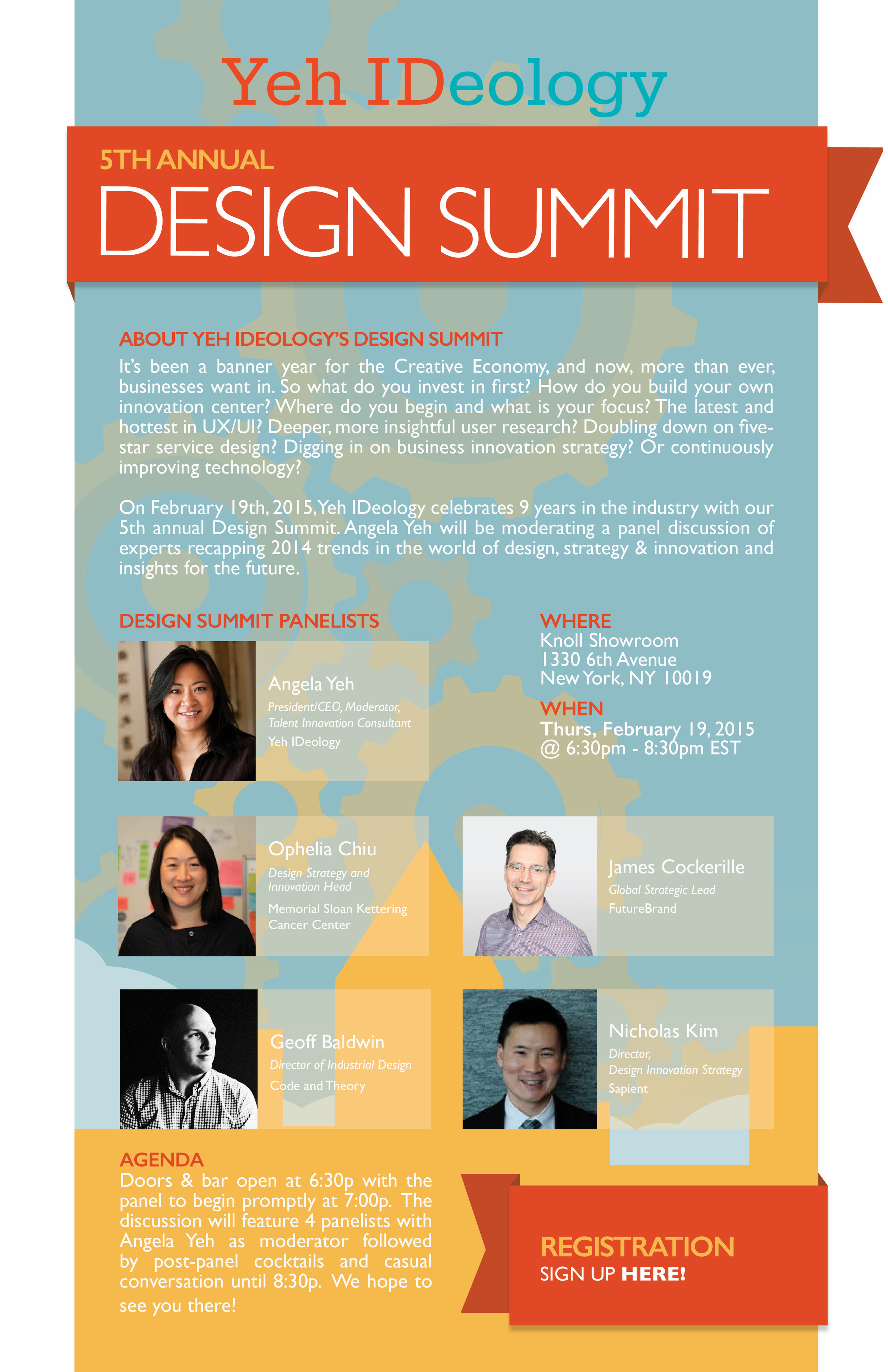Though change is the only constant in life, it's human nature to resist major change because of the risks associated with it. We do what we can to avoid rocking the boat too much, to keep...
Align yourself with Opportunities
Save the Date! 5th Annual Design Summit

About Yeh IDeology's Design Summit
It’s been a banner year for the Creative Economy, and now, more than ever, businesses want in. So what do you invest in first? How do you build your own innovation center? Where do you begin and what is your focus? The latest and hottest in UX/UI? Deeper, more insightful user research? Doubling down on five-star service design? Digging in on business innovation strategy? Or continuously improving technology?
This February 2015, Yeh IDeology celebrates 9 years in the industry with our 5th annual Design Summit.
Join us at Knoll Inc. Showroom for an informal, wide-ranging panel discussion with industry luminaries, as Angela Yeh recaps 2014 to share what we’ve learned and present our latest insights into what’s trending in the business of design, strategy, and innovation.
Registration Sign up here or paste this link into your web browser: https://eventbrite.com/event/8251262749/
Integrating Innovation Step 2
This past November, Angela Yeh, Founder and CEO of Yeh IDeology, took part in DMI’s Web Conversations, geared towards organizations and business owners, management and hiring managers with the specific topic challenge: "How to Build Innovation into Your Organization” In this series, we’ll be revisiting Angela’s talk, “Integrating Innovation,” while highlighting excerpts, thoughts from the talk, and delving further as we go into each of Angela’s 7 best tips for innovation success and 3 major pitfalls to avoid.
Shall we continue?
INTEGRATING INNOVATION Step #2: Scaling Innovation. Incremental or Monumental.
Last week’s blog focused on identifying the types of innovation best suited to your organization and the challenges at hand. Call it the “What” and “Where.” Which brings us to “How much?”
So you’ve identified the change you want – but what amount do you need? To what extent are you even capable of now in the near-term, and going forward with the right resources and investment? We’ll discuss the latter in Step 5, but for now, let’s focus on another essential part of the Discovery phase: Scale.
Clients often come to us and say: “It’s time for us to build an innovation center.” We hear this a lot. But for what purpose? Let me say that in every organization, there are multiple initiatives that have to be invested in. Some of them will be incremental, and some will be monumental and some will be low hanging fruit, and some will require a great deal of investment, and a lot more collaborators brought in to really make that initiative successful. It’s important to look at your organization first. If you can afford to build an “innovation center” outright, then so be it; that’s incredible. But in reality, the majority of businesses out there do not understand the amount of investment that this actually takes, and rarely are they set up to effectively execute this kind of monumental shift.
Pamela Decesare, DMI board member sums up the inherent challenges nicely: for most businesses, there’s “distribution channels, there’s methods, processes, and things they have in place to run the business as it is… How do they figure out how big a shift they need to make? How do they know what [kind of shift] they’re even willing to make?” More often than not, the changes you’re able to make initially towards innovation will be incremental.
So where do you begin? How do you assess and decide amongst the various priorities that exist if you cannot afford to build an entire innovation center? In most businesses, there is an existing structure in place, which can be complex to look at (and difficult to change), but there is a solution to this. It’s about being more analytical about your process and system, before you go ahead. I heard this term applied recently to this phase of a project – taking a diagnostic. A lean team has to look at the big picture; think of the strategy for their organization and brand / cross-brand; be mindful, and even champion, the challenges and goals of the various divisions (regardless of your team’s home base); and delve into the various sectors of the business, whether structural to the entire firm or specific to particular product categories. You have to list and, kind of, profile each challenge, and then collectively decide which of them to hit first.
This list, analysis, and resulting prioritization is the crux of this phase. Use this initial diagnostic – of both your department and company as a whole – to establish the foundation for determining your scale.
Next on our blog series: Step #3: Awareness of Innovation. Establishing the Baseline Amongst Your Stakeholders.
Interested in this topic or others we've been speaking about? Want to hear directly from Angela Yeh and her 15+ years of design recruiting experience? Drop us a line at info@yehideology.com
Integrating Innovation
As we barrel into the holiday season, one word on every business’ wishlist seems to be “innovation.” This past month, Angela Yeh, Founder and CEO of Yeh IDeology, took part in DMI’s Web Conversations, sharing her 7 best tips for innovation success and 3 major pitfalls to avoid. This week and in those to follow, we’ll be revisiting Angela’s talk in our blog series, “Integrating Innovation,” while highlighting excerpts, thoughts from the talk, and delving further into each as we go.
Shall we begin?
Step #1: Defining Innovation. What and Where Change is Right for You.
Innovation means change. Pamela Decesare, member of the Board of Directors at DMI, said it aptly: “There is no doubt that companies today are quickly realizing that innovation is not an agenda item for an off-site meeting, or a serendipitous occurrence, but rather something that requires long-term goals, focused planning, internal and external examination, and ultimately, investment, to be meaningful and effective.”
Let's step back and talk about what we see going on right now – in design strategy and the overall “umbrella” of, call it, innovation space, we’re seeing thousands of individuals, today, migrating to the vertical sector of design, strategy, and innovation.
The disconnect that we’re noticing, however, is that on one hand, there are many individuals building immense design capability, while on the other, from a business perspective, organizations observing this trend are frantically asking, “How do I capture this innovation and build it into the business? What method is best for me?”
With more than 15 years of working with diverse organizations, from major corporations and top consultancies, to startups and small agencies, one thing we can reaffirm again and again, is that there are many different ways to build innovation. There is no one-size fits all, universal solution. The “not-so-simple” fact is that innovation must be customized case by case.
What kind of change do you want? What kind of change do you need?
One of the most important aspects of innovation is what we call Discovery. In this early phase, discovery is a way to begin the conversation – not for solutions – to open a dialogue that will inform and constrain the rest of the initiative going forward.
In the Discovery phase, you and everyone involved should begin by asking: Where is your company today? This is where you take stock, a dip test for the current state of things which serves as your baseline to work from. An annual report is a good starting point.
Next, ask yourself: Where do you want to go? What are the 1, 2, 5 and 10-year goals for your company? Keep the bar high, as there will be plenty of opportunities to dive into the details later. With higher targets in mind, the further you can reach. Identify aspects that are working well within your company, and those conducive towards your goals. And equally important, diagnose ones that are not working well.
Being able to construct questions that help gain valuable insights is a challenge, but a first step closer to your goal! Stay tuned for step two to Integrating Innovation...
Next on our blog series: Step #2: Scaling Innovation. Incremental or Monumental
Interested in this topic or others we've been speaking about? Want to hear directly from Angela Yeh and her 15+ years of design recruiting experience? Drop us a line at info@yehideology.com




